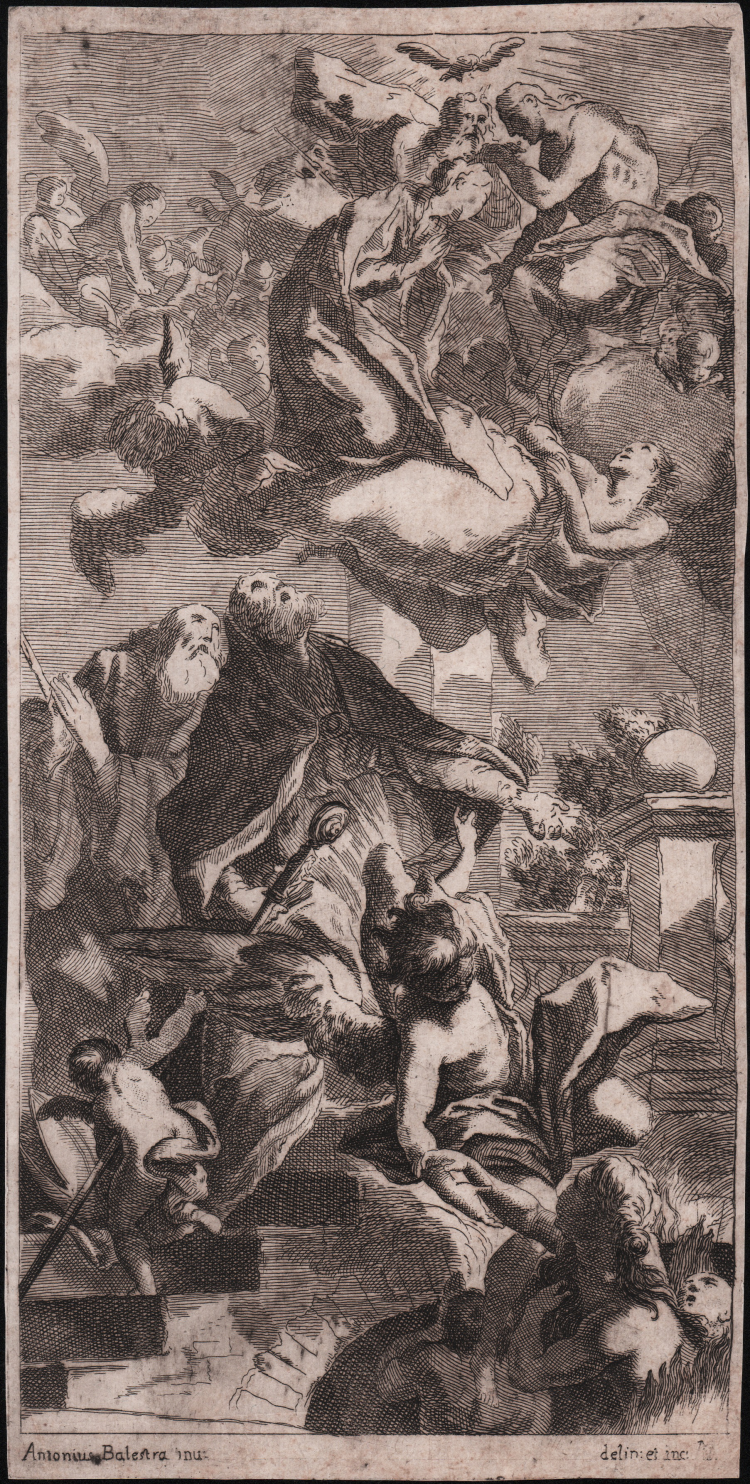




| Reference: | s47061 |
| Author | Antonio BALESTRA |
| Year: | 1731 ca. |
| Measures: | 150 x 300 mm |



| Reference: | s47061 |
| Author | Antonio BALESTRA |
| Year: | 1731 ca. |
| Measures: | 150 x 300 mm |
Etching, circa 1731/37, signed on the plate at lower left 'Antonius Balestra inv. delin: et inc:
Extremely rare etching by Antonio Balestra, based on one of his own paintings.
The work is described only by Ozzola - in Thieme-Becker p. 408; neither Paolo Bellini (Antonio Balestra in The Illustrated Bartsch, n. 011) nor Gioconda Albricci Contributo per un catalogo delle incisioni di Antonio Balestra pp.81-82), citing Ozzola, have been able to find a copy of the etching.
Albricci wrote: “Non abbiamo recuperato alcuna notizia sulla stampa citata da Ozzola nel Thieme-Becker: Madonna con due Santi. Il Battisti (84), nel suo elenco di dipinti certi del Balestra, ne elenca tre con questo soggetto: uno rappresenta La Beata Vergine, S. Ignazio e S. Stanislao, del 1731; l'altro è la Madonna col Bambino, S. Antonio da Padova e S. Domenico, del 1731-33; il terzo è La Vergine, S. Chiara e S. Antonio, dipinto nel 1737. Uno di questi tre dipinti potrebbe essere stato riprodotto in incisione, ma non è stato fino ad ora trovato elencato”.
Bellini wrote: “This work was attribuited to Balestra by Ozzola, but non impression of it have been found. Albricci states that she has not examine this etching but notes that Balestra made three paintings with the subject of the Madonna with two Saints, and says that the etching may be after one of these paintings”.
Antonio Balestra, a native of Verona, was a pupil of Carlo Maratta in Rome. A vast and well-informed contemporary literature, which often made use of information provided directly by the artist, and a group of autograph letters allow us to know not only the external events of Balestra's life, but also the principles by which he inspired all his artistic activity, which took place in a context of taste clearly marked by the Roman tradition, which he nevertheless interpreted with formal fluidity and fluency of Correggio's inspiration, reflecting those aspirations of his time that were decisive for the passage of taste from the seventeenth to the eighteenth century.
Rarely has an artist been so highly esteemed by his contemporaries as Balestra, whose classicizing painting in fact coincided with the dominant academic taste. Modern critics have instead given him a rather limiting judgment, recognizing more than a poetic validity a historical importance, as he contributed to introduce in the Veneto, by then closed in traditional forms provincialize, the Roman culture, which did not fail to have reflections also in Piazzetta and in the young Tiepolo
Gioconda Albricci reduces to 10 the graphic corpus of Antonio Balestra; previous etchings attributed to him by Bartsch, Nagler and Bruillot are in fact derubricated and assigned to his pupil Pietro Rotari.
A good example of this extremely rare work.
Bibliografia
L. Ozzola, Balestra Antonio, in “Allgemeines Lexicon”, vol. 2, p. 408; Albricci G., Contributo per un catalogo delle incisioni di Antonio Balestra, in “Saggi e memorie di Storia dell'Arte”, Venezia 1982, pp. 81/82; P. Bellini, Antonio Balestra in “The Illustrated Bartsch” p. 111, n. 011.
Antonio BALESTRA (Verona 1666 – 1740)
|
Italian painter and printmaker. His altarpieces and history paintings, which unite late Baroque classicism with Venetian colour, brought new life to northern Italian painting. Son of Lucia Boschetti and Francesco Balestra, a wealthy merchant, he studied literature, rehetoric and the humanities, but, after lessons in drawing and perspective with Giovanni Zeffis (d 1688) and one Monsignor Bianchini (1646–1724), he moved to Venice in 1687 and trained with Antonio Bellucci. In 1691 he mouved to Rome, where he studied with Carlo Maratti, whose art continued a classical tradition that can be traced back to Raphael, and where he also absorbed the work of Annibale Carracci and Domenichino. In 1694 Balestra’s large drawing of the Fall of the Giants (Rome, Gal. Accad. N. S Luca) won first prize in a competition at the Accademia di S Luca. In 1695 he returned to Verona, where he was acclaimed as the chief exponent in the Veneto of Maratti’s late Baroque classicism. His pictures of this period were mainly small religious works, such as the Agony in the Garden (London, priv. col.).
|
Antonio BALESTRA (Verona 1666 – 1740)
|
Italian painter and printmaker. His altarpieces and history paintings, which unite late Baroque classicism with Venetian colour, brought new life to northern Italian painting. Son of Lucia Boschetti and Francesco Balestra, a wealthy merchant, he studied literature, rehetoric and the humanities, but, after lessons in drawing and perspective with Giovanni Zeffis (d 1688) and one Monsignor Bianchini (1646–1724), he moved to Venice in 1687 and trained with Antonio Bellucci. In 1691 he mouved to Rome, where he studied with Carlo Maratti, whose art continued a classical tradition that can be traced back to Raphael, and where he also absorbed the work of Annibale Carracci and Domenichino. In 1694 Balestra’s large drawing of the Fall of the Giants (Rome, Gal. Accad. N. S Luca) won first prize in a competition at the Accademia di S Luca. In 1695 he returned to Verona, where he was acclaimed as the chief exponent in the Veneto of Maratti’s late Baroque classicism. His pictures of this period were mainly small religious works, such as the Agony in the Garden (London, priv. col.).
|